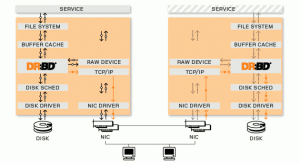DRBD has been a long standing external patch in many distribution kernels. It has finally been merged in the 2.6.33 window. Colloquially the "Distributed Redundant Block Device", this piece of code allows you to mirror blocks of storage across multiple nodes.
This is primarily useful in high availability setups. By synchronously mirroring storage across two systems, you can run an active-passive cluster where the backup machine will take over if the primary fails. Using a more advanced clustering file system such as GFS2 or OCFS, you can even do active-active setups although there are certain considerations there.
This is exciting because it alleviates the need for specialized hardware like SAN storage. Standard Linux servers with direct attached storage may be used and indeed even give appreciable performance. In practice, redundancy will be even greater than all but the highest end SAN equipment due to the lack of single point of failure.
DRBD also allows for asynchronous mirroring, that is, writes to the primary do not wait on completion to the secondary. This is useful for cold site backups and perhaps meeting legal compliance in certain industries as well.
Take a look at the DRBD site for more information and use cases.

Comments
comments powered by Disqus